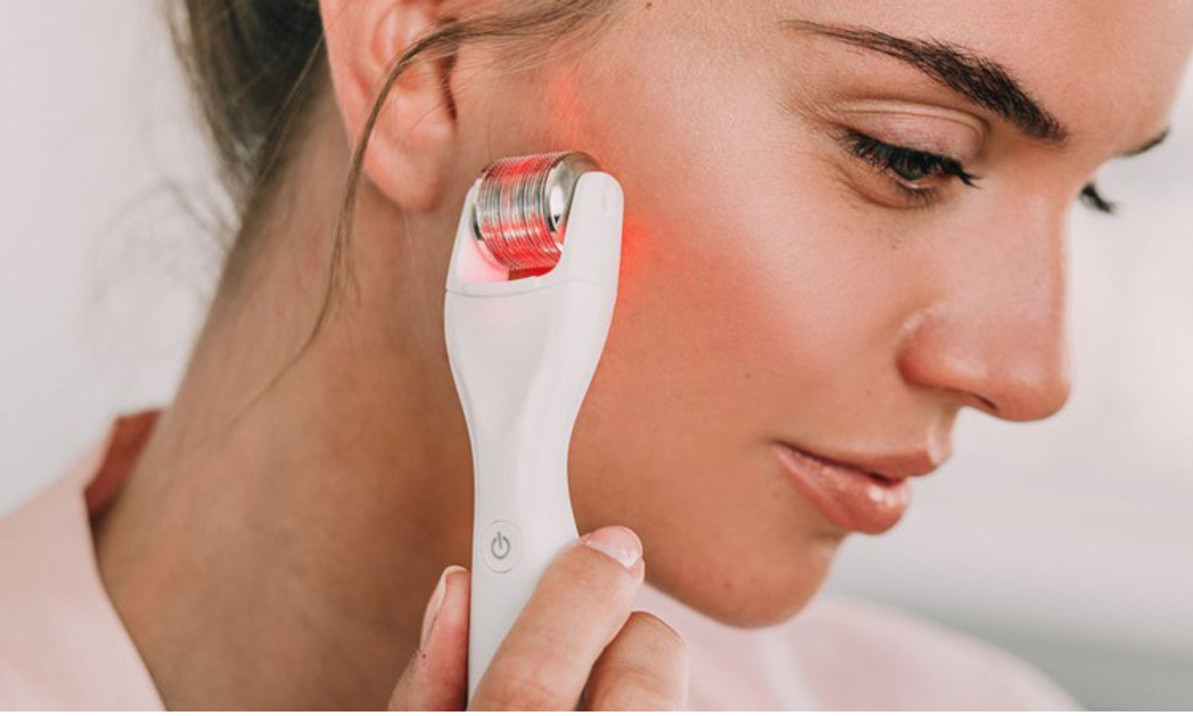Microneedling with Hyaluronic Acid Serum or Niacinamide Serum
Microneedling, also known as collagen induction therapy, is a procedure that is used only in a licensed professional spa. This procedure aimed to achieve younger, smoother, clearer-looking skin by stimulating collagen production using collagen induction therapy. It became popular because it improves fine lines, wrinkles, and skin texture with little recovery time. In addition, it is not as invasive as other procedures like chemical peels, dermabrasion, laser resurfacing, etc.
In-office cost of microneedling can range from $200-$700 a session and require three to six visits for optimal results. However, with devices like a derma-roller, a form of microneedling, this procedure can be done at home for much less and, if done correctly, can be used on sensitive skin.
What is a derma-roller?
A derma-roller is a handheld mini wheel covered in tiny sterile needles to create microscopic controlled skin injuries. Derma-rollers are designed with needle depths varying from 0.5 -2 mm. The chart below defines the needle depth used to treat specific issues.
Treatment Needle Length: Transdermal absorption 0.25 mm Shallow wrinkles, scars, UV damage, hyperpigmentation 0.5 mm sun damage, shallow to deep wrinkles/spots, stretch marks 0.75 - 1 mm Severe scarring or stretch marks (Not recommended at home or on the face) 1.5 - 3 mm.
How Does a derma-roller Work?
Derma-rolling works by rolling the device over your face or body and inserting the tiny needles into your skin. This process creates microscopic skin wounds that trigger the body's natural healing process, stimulating collagen and elastin production and allowing new blood vessels to form.
Benefits of derma-rolling
Transdermal absorption: Derma-rolling creates microchannels to improve skincare products' absorption, increasing their effectiveness.
Fine lines and Wrinkles: Collagen and elastin production are stimulated with a Derma-roller to help skin naturally fill in wrinkles.
Hyperpigmentation: Derma-rolling helps to lighten hyperpigmentation by breaking up melanin clusters. It also allows the skin to absorb treatment products better to improve results.
Scars and Skin Texture: It stimulates the repair process by immediately boosting the production of more collagen. The increase in collagen and elastin production helps with repairing skin irregularities.
Stretch marks: The appearance of stretch marks can improve with a Derma-roller by stimulating collagen production and enhancing the absorption of stretch mark treatment products.

How to Use a derma-roller in 6 steps
Step 1: Disinfect the derma-roller with a cosmetic alcohol spray.
Step 2: Cleanse and tone your skin.
Step 3: Apply numbing cream if needed. Apply hyaluronic acid serum or niacinamide serum.
(When used with hyaluronic acid or niacinamide, the derma-roller will drive hydration into the skin. This can also be accomplished using serum rich sheet mask)
Step 4: Using even, gentle movements, guide the roller across the skin in one direction 6 to 8 times, always lifting off the skin before going over the area again. You will want to repeat the steps vertically, horizontally, and diagonally on each face section.
Step 5: Apply a repairing serum or your usual skincare routine
Step 6: Disinfect the derma-roller with rubbing alcohol.
How often can you use a derma-roller?
Depending on the length of the needle, the chart below is a guideline for how often the procedure should be performed. Make sure you allow the skin to heal and regenerate in between sessions.
Needle length (millimeters) How often 0.25 mm every other day 0.5 mm 1 to 3 times a week (starting with less) 1.0 mm every 10 to 14 days 1.5 mm once every 3 to 4 weeks 2.0 mm every six weeks (avoid this length for home use)

Is it painful to derma-roll your face?
Everyone has different pain tolerance. The pressure applied, the skin's sensitivity and the needles' size determine how painful it will be. Numbing cream can also be used to help with the pain.
Recovery and side effects from microneedling with hyaluronic acid serum and niacinamide
Although derma-rolling is minimally invasive, some side effects include redness, irritation, minor swelling, and a pulsing sensation. Peeling may also start to occur after two to three days.
At what age can I start micro-needling?
The best time to start this type of treatment is in your 20s, or 30's so that the boost in collagen production will be more significant, and you can train your skin on how often it needs to produce, keeping wrinkles at bay.
What is collagen and elastin production?
Collagen is an abundant protein that accounts for 90% of human structural proteins. It's made primarily from amino acids such as glycine, proline, and hydroxyprolines, forming three strands to create its triple-helix structure. Collagen is a structural protein that provides vital assistance to tissues. It can be found in connective tissue, skin, and bones, among other places. Connective-tissue cells called fibroblasts produce it while maintaining your body's integrity by helping with cellular processes like repair or immune response because they're so essential for everyday functioning.
However, as people grow older, their collagen becomes fragmented, fibroblast function becomes impaired, and collagen production slows. As a result, the body's ability to produce elastin and collagen is lost with age, causing sagging skin that easily creates fine lines and wrinkles.

What is niacinamide?
Niacinamide is a water-soluble version of vitamin B3 that the body uses to produce energy. It can be found in various grains, meats, and dairy products, as well as being an ingredient for skincare products such as anti-aging or acne treatments because it helps strengthen your skin's moisture barrier against external stressors like pollution UV exposure, harsh elements, etc., which leads us topically using niacinamides for strength here on out. It also increases the skin's antioxidant capacity, allowing it to resist damage or irritation caused by these environmental stressors.
What does niacinamide do for your skin?
Niacinamide supports the skin barrier and improves texture by making pores look smaller. It also helps balance oil production and is suitable for all skin types. In addition, niacinamide helps soothe your skin and keep it moisturized. This skin-restoring ingredient helps reduce the appearance of blemishes and brightens skin. Niacinamide, also called nicotinamide, is a form of vitamin B-3, an essential nutrient. Taking niacinamide can help prevent B-3 deficiency. Although more research is needed, topical niacinamide may help treat certain skin conditions, including acne and eczema.
What is hyaluronic acid?
Hyaluronic acid is an excellent moisture-binding ingredient naturally produced by our body. Some studies have shown that hyaluronic acid helps improve collagen production, fight free radicals, maintain skin elasticity, and provide antibacterial and anti-inflammatory properties that help with wound healing. The average human body contains about 15 grams of hyaluronic acid. But one-third of that gets degraded and synthesized daily. As we age, we also produce less and less, so many anti-aging products contain hyaluronic acid. In addition, plastic surgeons and board-certified dermatologists often inject hyaluronic acid into recessed areas of skin to plump it up.
What is hyaluronic acid suitable for?
Hyaluronic acid is a sugar molecule that occurs naturally in the skin and helps to bind water to collagen, trapping it in the skin, so that skin can appear plumper, dewier, and more hydrated. Since our bodies produce it, it is a great natural option for anti-aging skincare. In addition, hyaluronic acid can be used following microneedling, and it's even recommended in some cases to help stimulate collagen.
Hyaluronic acid is well known for its skin benefits, significantly alleviating dry skin, reducing the appearance of fine lines and wrinkles, and speeding up wound healing. It can also help relieve joint pain. Moisturizers and serums are two of the most common forms of hyaluronic acid. Use a moisturizer infused with hyaluronic acid at the time when you'd usually moisturize. Ideally, this would be done twice a day after cleansing, exfoliating, or applying serums.
Can you use niacinamide and hyaluronic acid together?
The short answer is yes; you can use niacinamide and hyaluronic acid together. This combination can offer a double-whammy of skin hydration as well as several other benefits. So how do you layer the two? Start by applying hyaluronic acid on your cleansed face to replenish your skin first, and then follow up with niacinamide to regulate excess sebum production. Lastly, lock these active ingredients in with your favorite moisturizer. Acids like vitamin c should wait about a week or more after treatment to be safe, as it creates skin sensitivity to UV light.
Recent Posts
-
The Complete Guide to Lash Lifts
The Complete Guide to Lash Lifts I love finding new trending beauty tips that can cut down on my mo …Jan 24th 2025 -
The Best Eyelash Growth Serum
The Best Eyelash Growth Serum: Our Top Picks for Length and Volume As a woman, wanting natural, lon …Jan 17th 2025 -
Clareblend Mini Microcurrent Facial Device Specs and Reviews
Clareblend Mini Microcurrent Facial Device Specs and Reviews Clareblend Inc. was founded in 1927 bu …Jan 7th 2025




